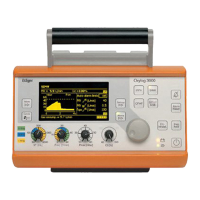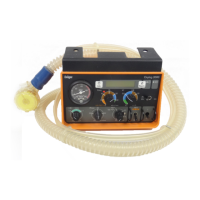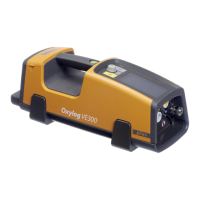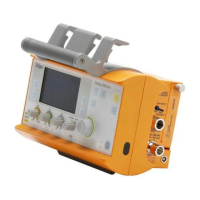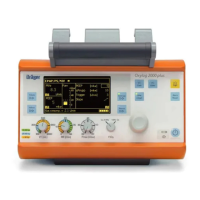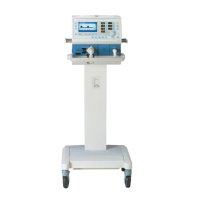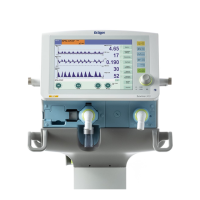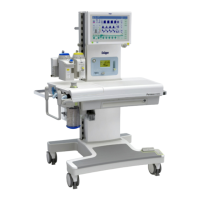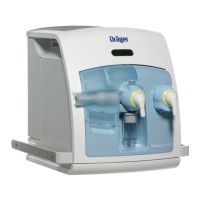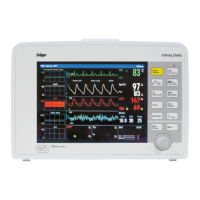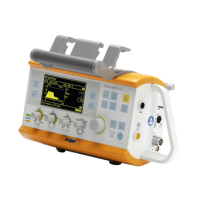
Do you have a question about the Dräger Oxylog 3000 plus and is the answer not in the manual?
| PEEP | 0 to 20 cm H2O |
|---|---|
| Device Type | Ventilator |
| Type | Transport ventilator |
| Power Supply | AC power and rechargeable battery |
| Display | LCD display |
| Humidity Range | 15 to 95 % relative humidity, non-condensing |
| FiO2 | 21% to 100% |
| O2 Concentration | 21 to 100 % |
General safety guidelines and warnings applicable to the medical device.
Safety information specific to the Oxylog 3000 plus device features.
Specifies the intended application and target user of the ventilator.
Details patient conditions for use and situations where the device should not be used.
Outlines permissible and prohibited environments for operating the device.
Provides a detailed description and labeling of the ventilator's main components.
Lists the various ventilation modes and additional settings available on the device.
Explains common abbreviations used throughout the documentation.
Defines the meaning of symbols used on the device and in the instructions.
Instructions for powering the device on and off safely and correctly.
Explains the physical controls used for setting ventilation parameters and modes.
Details the function of keys and the rotary knob used for navigating and setting parameters.
Describes the layout and different windows of the device's user interface.
Covers the process of removing, inserting, and checking the status of the internal battery.
Provides instructions for connecting external power sources like AC/DC packs or DC/DC converters.
Details how to connect the ventilator to an O2 cylinder or central gas supply system.
Step-by-step guide for assembling the reusable breathing circuit components.
Instructions for connecting the single-use disposable breathing circuit for adult patients.
Instructions for connecting the single-use disposable breathing circuit for pediatric patients.
Explains how to connect bacterial filters or Heat and Moisture Exchangers to the circuit.
Describes the procedure for connecting the CO2 sensor and cuvette to the device.
Guidance on mounting the ventilator onto standard rail systems.
Explains how to charge the internal battery and indicates its status.
Provides a method to estimate the ventilator's operating time based on O2 supply.
Outlines the necessary checks to ensure the device is ready for safe operation.
Details the steps involved in conducting the automated device self-test.
Instructions for performing optional CO2 sensor calibration and filter checks.
Final steps to prepare the device for ventilation after all checks are complete.
Steps to initiate the ventilator's operation after assembly and checks.
Covers activating and setting parameters for various ventilation modes.
Details the Volume Controlled - Controlled Mandatory Ventilation and Assist Control modes.
Explains Synchronized Intermittent Mandatory Ventilation and its PS variant.
Describes Pressure Controlled - Biphasic Positive Airway Pressure modes.
Explains Spontaneous Continuous Positive Airway Pressure modes.
Instructions for activating and using Non-Invasive Ventilation.
Details functions like manual inspiration, 100% O2, and O2 inhalation.
Explains how the device adjusts O2 concentration based on airway pressure and flow.
How to adjust settings for heat and moisture exchangers affecting flow measurement.
Information on automatic sensor calibration performed by the device.
How to adjust the screen brightness and power save mode.
How to set the audible alarm volume levels.
Procedures for safely switching off the ventilator.
Warnings and precautions regarding the alarm system and user awareness.
Explains the different levels of alarm priority and their indicators.
How alarm messages and signals are presented visually and audibly.
Instructions for configuring upper and lower alarm limits for various parameters.
How to view airway pressure, flow, and CO2 curves on the display.
Instructions for navigating and viewing various measured patient and device parameters.
Details on using the optional CO2 measurement feature and its settings.
Information on transferring data via the MEDIBUS.X protocol to external devices.
How to view current device settings, language, and battery information.
Accessing and using the service mode for tests and advanced configuration.
Configuring initial device settings like ventilation mode, hose type, and date/time.
Procedure for testing the functionality of the device's front panel controls.
How to test the device's audio and visual output components.
Steps for performing zero calibration and filter checks on the CO2 sensor.
A comprehensive table listing alarms, their causes, and recommended remedies.
Explains common alarm messages, their causes, and solutions.
Lists and explains informational messages displayed by the device.
Identifies and explains error messages encountered during the device self-test.
Crucial safety guidelines regarding reprocessing of reusable medical devices.
Steps to take before disassembling and reprocessing the device and its accessories.
Details on approved methods for cleaning and disinfecting device components.
Procedures for cleaning and disinfecting the device's external surfaces.
Instructions for using washer-disinfectors for thermal disinfection of components.
Specifies recommended intervals for device inspection and preventive maintenance.
Explains key terms related to device maintenance, inspection, and repair.
Guidelines and requirements for performing regular safety inspections of the device.
Detailed procedures for performing safety checks to ensure proper operation.
Outlines the maintenance schedule and required measures for components.
Recommendations for performing repairs and using authentic Dräger parts.
Guidance on actions to take in the event of a device failure.
Instructions and regulations for the environmentally sound disposal of the medical device.
Specific guidance for disposing of the device, power supplies, batteries, and circuits.
Specifies operating, storage, and transportation temperature, pressure, and humidity limits.
Lists the ranges and default values for various ventilation and device settings.
Details device compliance, resistances, and flow rates with different breathing circuits.
Technical specifications for airway pressure, flow, CO2, and frequency measurements.
Technical details on alarm limits and parameters monitored by the device.
Technical specifications for data transfer protocols and settings.
Information on power supply, consumption, battery life, and charging.
Physical dimensions, weight, sound levels, and screen specifications.
Compliance with electromagnetic compatibility standards and guidelines.
Detailed explanation of each ventilation mode supported by the device.
Explanation of the AutoFlow function and its behavior.
Discussion of dead space in the breathing system and its impact.
How the ventilator determines ventilation timing parameters based on settings.
Overview of the device's pneumatic system and how it functions.
Explains the principle and operation of the CO2 measurement system.
Information for authorized personnel on how to access the device's service mode.
